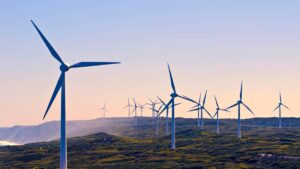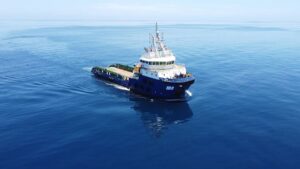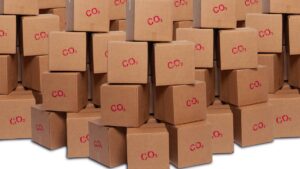POWER UP: AEMO sees renewables galore in its crystal ball

I see a lot of solar panels... Pic: via Getty Images
The Australian Energy Market Operator (AEMO) has released its much-anticipated Integrated System Plan after rigorous discussions and analysis, and it includes a number of key findings – some rather surprising – about how Australia’s electricity market will look over the next 30 years.
First off, and one that shouldn’t surprise anyone, is that as consumers and industry wean themselves off fossil fuels for heating and industrial processes, the amount of electricity required will climb and renewable energy supply will have to increase substantially to meet this demand.
In its “Step Change” scenario – also known as “This is what we think will most likely happen” – the AEMO believes that by 2050, the amount of electricity will increase by nearly 80% from the under 180 terawatt hours per year to about 320TWh per year.
To achieve this without coal, this will require a nine-fold increase in utility-scale variable renewable energy (VRE) capacity, and a near five-fold increase in distributed solar photovoltaics (like those lovely solar panels you find on your roof).
Here’s why renewables aren’t likely to cut your power bills in the near-term.
It will also require a 300% increase in firming capacity from alternative sources to coal that responds to sudden increases, be they utility-scale batteries, hydro storage, smart behind-the-meter “virtual power plants”, or gas-fired generation – cue hate mail from the green lobby.
For even more fun and games, Australia will need to adapt complex networks and markets for two-way electricity flow, prepare the power system for 100% instantaneous penetration of renewables, and install more than 10,000km of new transmission.
Thank goodness that one of key promises that got Labor elected was to spend some $20bn to rebuild and modernise the grid in line with the AEMO’s blueprint, eh?
All this may seem daunting, but it’s worth pointing out that the adoption of renewables has continually outpaced previous estimates and while current inflationary pressures might slow things down, the near certainty that the government will step in to support at least some projects could just be enough to offset this.
You ain’t seen nothing yet
Now remember how we noted that this is based on the Step Change scenario? Well a good percentage (about 17%) of the more than 1,500 stakeholders consulted believe that Australia might be headed towards the “Hydrogen Superpower” scenario.
If you thought that the AEMO’s forecast for the Step Change scenario was daunting, you might want to sit down before you hear what turning Australia into a hydrogen exporting superpower (the future, clean version of our LNG industry) would entail.
Under the Hydrogen Superpower scenario – and its optional cape, Australia will need to nearly quadruple its energy consumption to support an export industry – a scale of development that the AEMO quite rightly describes as monumental.
That’s a lot of solar panels and wind turbines, but Australia has plenty of empty space, so it’s a fair bet we can dodge the NIMBYs at least.
Yep, that’s ‘Not in My Backyard’. Very few people actually desire to open their backdoor and gaze up giant wind turbines.
The actual requirements are likely to be somewhere in between the two scenarios. The impetus to decarbonise is strengthening and there is every reason to believe that the Step Change scenario can be achieved – even if some gas sneaks past.
Going all out on becoming a hydrogen exporter is somewhat more challenging, though not entirely impossible.
Reports of coal’s death are NOT greatly exaggerated
The other big change predicted by the AEMO was likely greeted with much jubilation from the green lobby, and that is the faster than expected withdrawal of coal-fired generation with 60% shut by 2030.
Despite the wishes of certain members of the previous government – famous for brandishing pieces of the fossil fuel in parliament – the AEMO clearly thinks that coal’s days are numbered. Its Step Change scenario predicts the exit of Victoria’s notorious brown coal generators by 2032.
Other coal plants – burning somewhat less polluting black coal – are expected to close by 2042, rather predictably in Queensland, the state with the largest quantities of that fossil fuel.
Quite predictably, the more extreme Hydrogen Superpower scenario sees coal exiting stage right even sooner with some 20 gigawatts of the current 23GW of installed capacity forecast to be withdrawn by 2030.
It is not hard to see where the AEMO is coming from with Origin Energy’s decision to shut Eraring – Australia’s biggest electricity generator – earlier than expected, highlighting why it believes this to be the case.
And while Western Australia’s energy market is separate from the rest of Australia, the state government’s commitment to end coal-fired power generation by 2030 lends further support to this premise.
AEMO sees great value with a great deal of urgency
The remaining point that the AEMO made is pretty self-explanatory, which is that the transmission projects in the Optimal Development Path are forecast to deliver scenario-weighted net market benefits of $28bn, or about 2.2 times their cost of approximately $12.7bn.
This represents just 7% of the total investment in NEM generation, storage, and network to 2050 but will optimise benefits for all who produce, consume and transport electricity in the market while providing both investment certainty and the flexibility to reduce emissions faster if needed.
However, it noted that all of the transmission projects are needed and their development should be prioritised given their estimated delivery timeframes.
Related Topics
UNLOCK INSIGHTS
Discover the untold stories of emerging ASX stocks.
Daily news and expert analysis, it's free to subscribe.
By proceeding, you confirm you understand that we handle personal information in accordance with our Privacy Policy.








